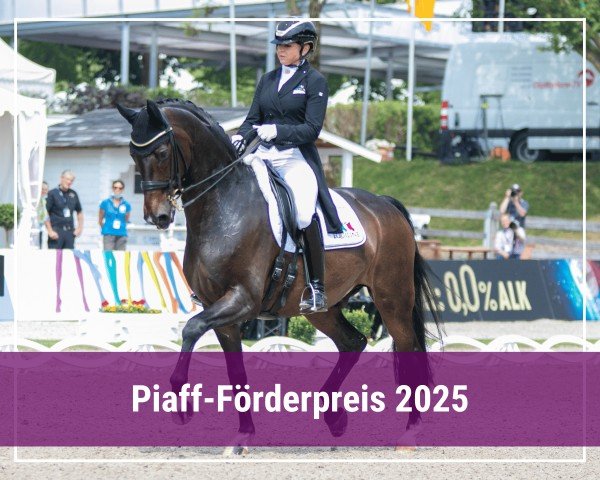rimondo Performance Score
The maths behind the RPS - for number crunchers!
With the rimondo Performance Score, we have developed the fairest sporting evaluation system that not only takes into account your performance level, but also the number of competitors.

Want to know the exact maths? Then here's a deep dive into the maths that drives our rimondo Performance Score (RPS). Dive into the world of numbers and formulas behind the assessment of your riding performance:
Base value for each test level
Each test level (e.g. E, A, L, M*, M**, etc.) has a predefined base value. This value reflects the level of difficulty and importance of the particular test. Logically, higher levels have higher base values, reflecting the greater challenge and increased demand. Special tests are given an extra boost. For example, the final of the Bundeschampionate for 6-year-old dressage horses is given a value 5 times higher than a medium dressage test for young horses at a normal show!
Adjustment according to the number of competitors: Logarithmic scaling
In order to include the "number of competitors" factor fairly, we use logarithmic scaling. It looks like this:
Formula:
Test points = base value * ln(number of competitors)
Aim:
To give greater weighting to larger fields of competitors without increasing the points immeasurably.
Limits:
To keep everything fair, there is a lower limit (at least 2x the base value) and an upper limit (maximum 4x the base value) for the test points.
Distribution of points within the field of competitors
The best 3/4 of the competitors receive points based on their ranking. But be careful: A maximum of 30 competitors, but at least all placed ones receive points. Calculation: The last in this group receives 1 point, each better ranked competitor successively more. And here's the trick: there are additional extra points for placed competitors. The last-placed competitor receives an extra point, and each better-placed competitor receives an additional extra point. Two extra points are given for winning.
Calculation of the RPS value
Now for the grand final - the calculation of the RPS value itself:
Formula:
RPS = (points achieved / maximum number of points) * test points
Aim:
With this formula, we achieve a fair and comparable assessment of your performance across different levels and competitor field sizes.
Examples
Example 1: A victory in an M* test with 10 starters
Calculate test points:
Base value = 175 (M* show jumping)
Number of competitors = 10 Test points = 175 * ln(10) ≈ 175 * 3.69 ≈ 403 points
As the test points are within our lower and upper limits, no adjustments are necessary.
Points distribution:
Since 10 competitors are taking part, the best 3/4, i.e. 8 competitors, will receive points. We assume that the best third, i.e. 4 competitors, are placed in this test. The fourth-placed competitor receives an extra point, and each better-placed competitor receives successively more points.
Example placings:
1st place: 8 points + 4 extra points for the placings + 2 extra points for winning = 14 points
2nd place: 7 points + 3 extra points for the placings = 10 points
8th place: 1 point
10th place: 0 points
Calculate RPS:
Since you received the maximum number of points, your RPS = (14/14) * 403 = 403 points.
Example 2: Medium placing in a big L dressage test
Calculate test points:
Base score = 25 (L-dressage)
Number of competitors = 40
Test points = 25 * ln(40) ≈ 25 * 3.69 ≈ 92 points
As the test points are within our lower and upper limits, no adjustments are necessary.
Points distribution:
With 40 competitors, the best 30 competitors receive points and 14 are placed.
Example placings:
1st place: 30 points + 14 extra points for placings + 2 extra points for winning = 46 points
2nd place: 29 points + 13 extra points for the placings = 42 points
5th place: 26 points + 10 extra points for the placings = 36 points
30th place: 1 point
Calculate RPS:
You received 36 points for your 5th place. Your RPS would then be (36/46) * 92 = 72 points.
Example 3: Third place in an S* dressage test with five competitors
Calculate test points:
Base value = 1,000 (S-level dressage)
Number of competitors = 5 Test points = 1,000 * ln(5) ≈ 1,000 * 1.61 ≈ 1,610 points
As our lower limit, 2 times the base value, is not reached, the test value is set to 2*1,000 = 2,000 points.
Points distribution:
As there are 5 competitors, the best 3/4, i.e. 4 competitors, receive points. We assume that the best 4 competitors are placed in this test. The fourth-placed competitor receives an extra point, and each better-placed competitor receives successively more points.
Example placings:
1st place: 4 points + 4 extra points for the placings + 2 extra points for winning = 10 points
2nd place: 3 points + 3 extra points for the placings = 6 points
3rd place: 2 points + 2 extra points for the placings = 4 points
4th place: 1 point + 1 extra point for the placings = 2 points 5th place: 0 points
Calculate RPS:
You have received 10 points for your 1st place. Your RPS would therefore be (10/10) * 2,000 = 2,000 points. The other competitors will then receive 1,200, 800 and 400 points.


